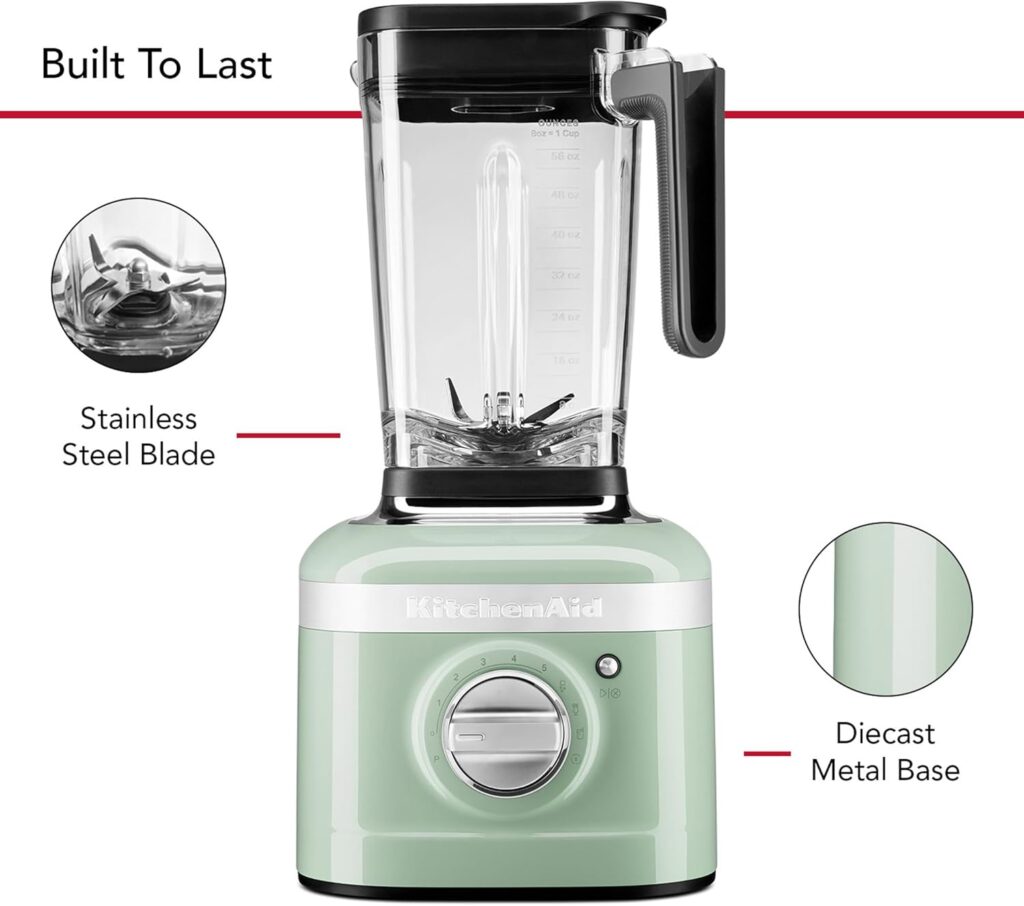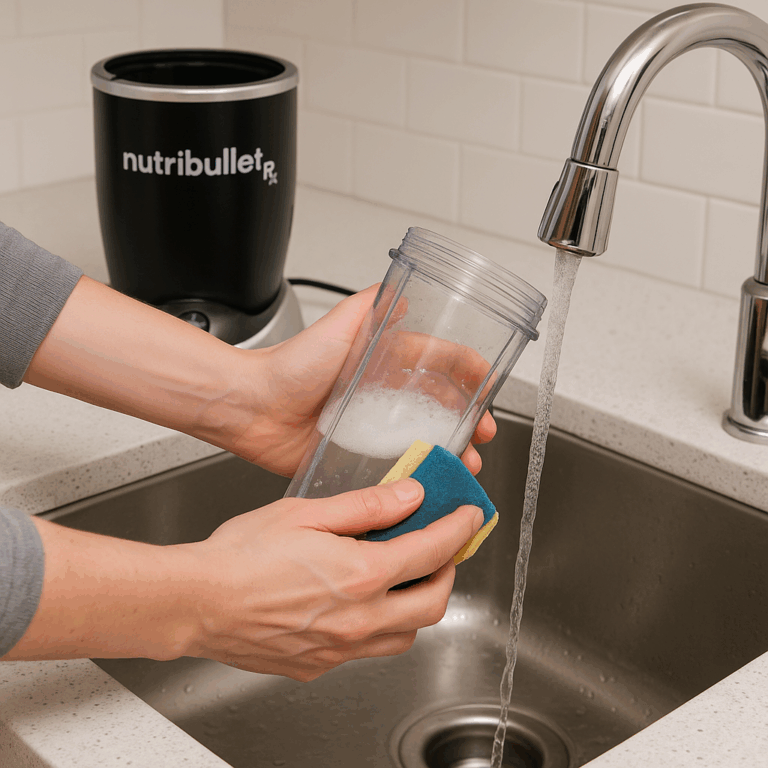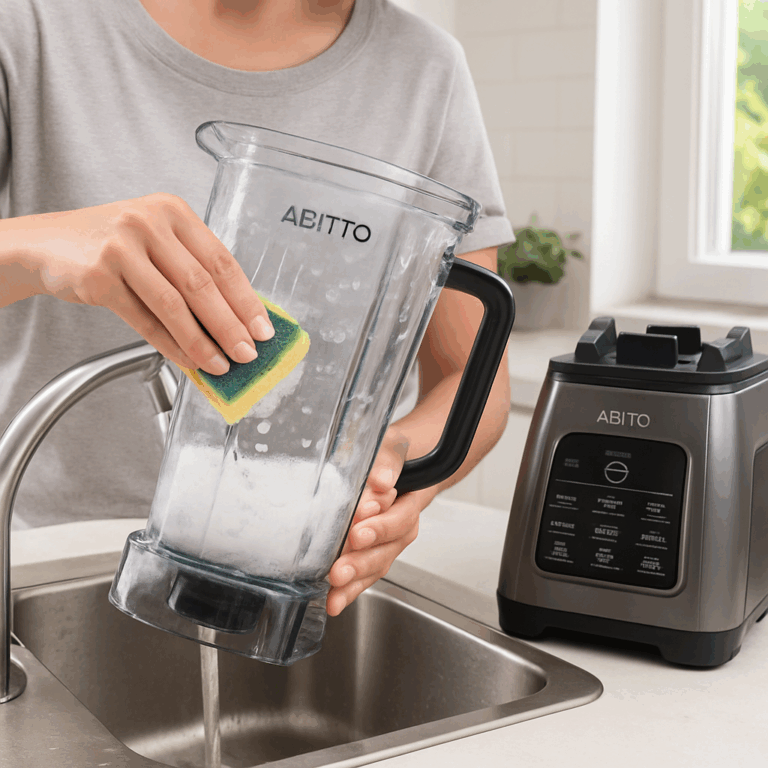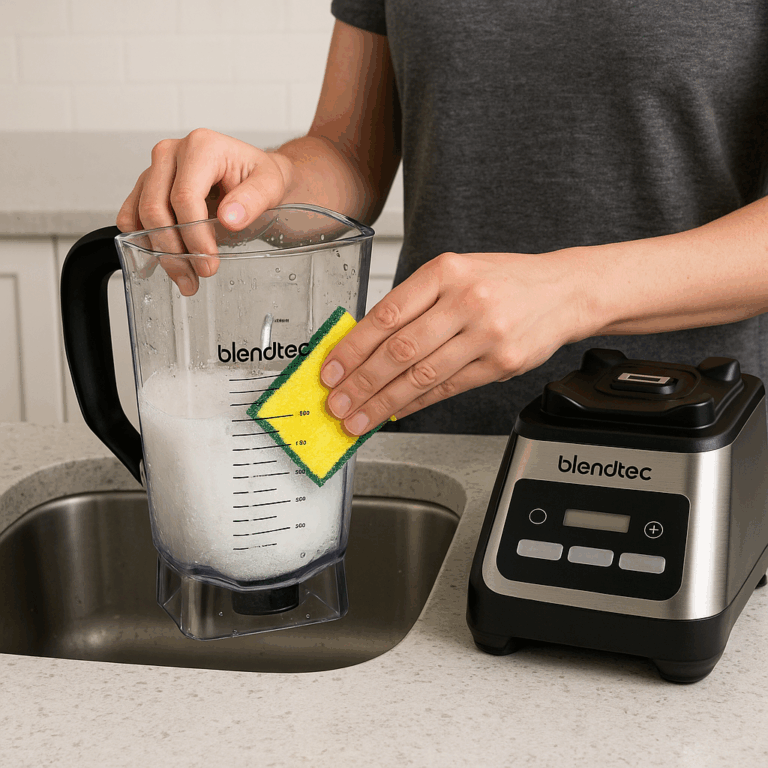
The KitchenAid K400 Blender is known for its balance of power and control, especially when blending tough ingredients like ice, fibrous greens, or nut butters. But to keep it performing at its best and preserve its sleek design, routine maintenance is key.
In this guide, you’ll learn how to clean and care for every part of your K400, from the jar and blade to the motor base and control dial. We’ll also cover how to remove stains, tackle odors, and avoid mistakes that shorten your blender’s lifespan. If you’re still getting familiar with this model, see our full KitchenAid K400 review for pros, cons, and performance breakdowns.
Table of Contents
Daily Cleaning Routine
Cleaning the K400 immediately after each use is the easiest way to avoid buildup and reduce wear.
Steps:
- Rinse Immediately – After pouring your blend, rinse the jar with warm water to dislodge leftover ingredients.
- Self-Clean Cycle – Add warm water and a drop of dish soap. Secure the lid and run the self-clean program (or blend on medium-high for 30 seconds).
- Rinse Again – Empty, rinse with clean water, and let the parts air dry upside down.
This process takes less than 2 minutes and prevents residue from hardening around the blades.
Deep Cleaning the Jar and Lid
Even if you clean it daily, a film can build up over time, especially from smoothies, nut butters, and dairy blends.
Deep Clean Method:
- Fill the jar halfway with warm water and 1 cup of white vinegar.
- Let sit for 10–15 minutes to break down the buildup.
- Blend on high for 30 seconds.
- Scrub the jar with a soft brush or sponge.
- Rinse and dry thoroughly.
The K400 lid’s seal can trap moisture or small food particles. Remove the gasket ring (if detachable) and hand-wash in soapy water every few days. This helps prevent mold and odor.
Blade Assembly Care
The K400’s blade is fixed in place and non-removable, which is convenient, but it also means cleaning must be consistent.
- Do NOT insert brushes or utensils into the jar when cleaning around the blade. Instead, use a long-handle bottle brush or let it soak to loosen dried-on residue.
- For heavy buildup, use a mix of warm water and baking soda to scrub gently.
Blades don’t need to be sharpened, but if you notice performance loss or clogs, the most likely culprit is residue in the blade well.
Cleaning the Motor Base
The base is where the K400’s power lives, and it deserves protection.
To clean:
- Unplug the unit before doing anything.
- Use a slightly damp microfiber cloth to wipe the surface.
- Gently brush around the control dial and buttons with a soft toothbrush.
- Dry immediately with a soft towel.
Avoid: Harsh chemicals, soaking the base, or wiping while plugged in.
To reduce splatter buildup, get in the habit of wiping the base weekly, especially near the control dial and rear vents.
Odor and Stain Removal
Stains and smells can linger after blending turmeric, garlic, onion, or beets.
Odor Removal Tip:
- Blend a mixture of 1/2 cup baking soda + warm water on high for 30 seconds.
- Let soak for 30 minutes before rinsing.
- Follow up with a lemon wedge blend for added freshness.
This deodorizing trick is safe for the jar and highly effective — especially if you switch between savory and sweet blends often.
Storage Tips
To keep your K400 in excellent condition between uses:
- Store the jar upside down to allow airflow and prevent odors.
- Keep the lid and gasket dry and separated after washing.
- Avoid tightly coiling the cord; instead, loop it loosely and tuck it behind the base.
- Place it away from direct sunlight or high-heat appliances.
Daily users can keep the jar assembled on the base, but only if everything is dry.
Troubleshooting Common Cleaning Issues
Cloudy Jar
- Soak in warm vinegar + water for 30 minutes.
- Scrub gently with a soft sponge.
Blender Smells Burnt
- Overloaded or blended too long. Let the motor cool for 20–30 minutes.
Food Residue Under Blades
- Soak with warm water + dish soap overnight.
- Use a long-handle bottle brush to clean under the blades the next day.
Maintenance Reference Chart
| Task | Frequency |
|---|---|
| Quick rinse & soap blend | After each use |
| Deep vinegar soak | Weekly |
| Baking soda deodorizing | Monthly |
| Lid + gasket hand wash | Every 3–5 days |
| Motor base wipe | Weekly |
| Full system inspection | Monthly |
FAQs
Can I put the K400 blender jar in the dishwasher?
Yes, the jar and lid are dishwasher safe. However, hand washing extends clarity and prevents fading.
How do I remove the smell of garlic from the jar?
Use baking soda + warm water, let sit for 30 mins, then rinse. Follow with lemon blend if needed.
Should I sharpen the K400 blades?
No, the blades are not meant to be sharpened. Performance issues are usually due to buildup, not dullness.
Common Mistakes That Damage Your K400
Even high-quality blenders like the KitchenAid K400 can develop problems when misused. Here are some of the most common mistakes people make, and how to avoid them:
1. Blending Without Enough Liquid
Dry or overly thick blends put excess stress on the motor and can lead to overheating. Always include enough liquid to maintain a smooth vortex.
2. Using Harsh Scrubbers or Metal Tools
Scrubbing the jar with steel wool or using metal utensils to dislodge food near the blade can scratch or cloud the container and damage the blade gasket.
3. Ignoring the Gasket Seal
Over time, food debris can build up under the lid’s gasket ring. If left unchecked, this can lead to leaks, mold growth, or loss of suction.
4. Storing Wet Parts
Putting the lid, gasket, or jar into storage while damp can lead to mildew, odors, or a cloudy finish on the container. Always let parts air dry completely before reassembly.
5. Using the Dishwasher Too Often
While dishwasher-safe, repeated exposure to high heat and detergent can dull the jar’s finish. Hand-washing is preferred for long-term clarity.
Avoiding these small but costly mistakes ensures your K400 remains a reliable kitchen tool for years to come.
How to Keep the Jar Crystal Clear Long-Term
The K400 jar is made of durable plastic designed to resist clouding, but over time, even the best materials can fog or discolor without the right care.
Tip 1: Rinse Immediately After Each Use
Even before you do a full clean, rinsing right after blending helps prevent stains from setting, especially when using colorful ingredients like berries or turmeric.
Tip 2: Alternate Soaks
Alternate between vinegar soaks (to dissolve mineral deposits) and baking soda soaks (to deodorize and lift residue). Doing this biweekly preserves the visual clarity of the jar.
Tip 3: Don’t Use the Dishwasher Daily
While it’s fine occasionally, frequent dishwasher cycles can cause micro-etching from harsh detergents. Hand washing with a soft sponge is gentler and preserves that like-new look.
Tip 4: Dry With Air, Not Towels
Microfiber cloths can scratch the surface over time. Instead, always air dry the jar upside down after rinsing or soaking.
Tip 5: Use a Dedicated Brush for the Blade Area
To avoid scratching or cloudy buildup near the blades, use a soft, narrow brush specifically for that area — and never metal or stiff brushes.
By following these practices, your K400 jar can stay clear and clean for years, making every smoothie look as good as it tastes.
Monthly Blender Maintenance Routine
For long-term performance, a monthly deep-clean routine goes beyond the day-to-day rinse. Here’s a complete checklist you can follow every 30 days:
1. Full Jar Soak
Fill halfway with warm water and white vinegar. Let sit for 30 minutes, blend briefly, and scrub.
2. Baking Soda Odor Flush
Blend baking soda and water to remove lingering smells, especially after blending garlic or onions.
3. Gasket & Lid Seal Cleaning
Remove the gasket ring (if detachable) and clean under it. Scrub the lid with dish soap and hot water to prevent mold or food buildup.
4. Blade Area Inspection
Shine a flashlight into the base of the jar and around the blade. Look for residue or mineral buildup and clean with a long-handle brush.
5. Motor Base Detail
Wipe the entire base, dial, and vent area with a damp microfiber cloth. Use a dry toothbrush to remove dust in crevices.
6. Cord & Plug Check
Make sure there are no frays or loose areas. Coil loosely when storing.
Set a reminder or mark your calendar monthly. Consistency keeps your K400 working like it did on day one, and might even extend the lifespan beyond its expected 10+ years.
Final Thoughts
The KitchenAid K400 is a great balance of strength and style, but like any appliance, it shines brightest when it’s well-maintained. Regular cleaning, deep soaks, and occasional inspections keep your blender looking and performing like it did on day one. For even more blender care tips across top brands, visit our Blender Upkeep Guide for detailed cleaning and troubleshooting guides.
Following the steps in this guide helps prevent odors, keeps the motor running cool, and extends the life of your jar and blades. And if you’re serious about getting long-term value from your blender, make this care routine part of your monthly habit.
Whether you’re blending power shakes or gourmet soups, the K400 will keep delivering consistent results, as long as you keep it clean. Looking for comparisons, reviews, and best picks across all models? Explore our Complete Blender Collection for top-rated blenders, side-by-side matchups, and expert recommendations.


